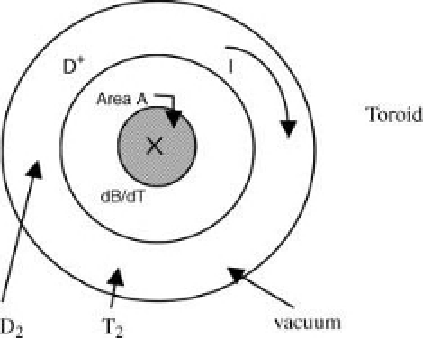Environmental Engineering Reference
In-Depth Information
Figure 4.7 Essential elements of Tokamak
reactor, top view. A toroidal vacuum chamber is
filled with deuterium and tritium gas at about
10
20
/m
3
density. Heating is applied to form a
neutral high-conductivity plasma of deuterons,
tritons, and electrons. A toroidal magnetic field
B, not shown, is in the range 1
produced by current through a superconducting
coil wound around the toroid. The plasma
current I is induced by a changingmagnetic flux,
AdB/dt, through the hole of the donut. The
toroidal device can be regarded as a solenoidal
coil of radius b, whose length is 2pa, closed on
itself to form a torus of volume V
2papb
2
.
5 Tesla,
¼
-
This catalytic approach to fusion has been measured and modeled, but has not
produced more fusion energy than needed to initiate the process.
In summary, muon-catalyzed fusion (
CF) is a process allowing
nuclear fusion
to
take place at
temperatures
signi
cantly lower than the temperatures required for
thermonuclear fusion
, even at
room temperature
or lower. Although it can be produced
reliably with the right equipment and has been much studied, it is believed that the
poor energy balance will prevent it from ever becoming a practical power source.
However, if
muons
(
m
m
) could be producedmore ef
ciently, or if they could be used as
catalysts
more ef
ciently, the
energy balance
might improve enough for muon-
catalyzed fusion to become a practical power source.
The observed time for fusion in DD
m
is 1.5 ns, and shorter in DT
m
, while the
lifetime of
is 2200 ns. This would allow for 1400 cycles, emitting one neutron plus
3MeVper cycle, but the best seen is only 200. This difference couldmake the process
useful for energy production. At present, it seems that something else is limiting the
neutron emission rate, maybe the time for a new DD
m
m
or DT
m
to form from the
released
, in the sample mixture of deuterium, DeeD and related DeeTmolecules.
This is perhaps limited by diffusion.
m
4.3
Deuterium Fusion Demonstration in Larger Scale Plasma Reactors
The essential elements of a Tokamak reactor are sketched in Figure 4.8. Here, a
toroidal vacuum chamber contains positive ions and electrons. A solenoid runs

